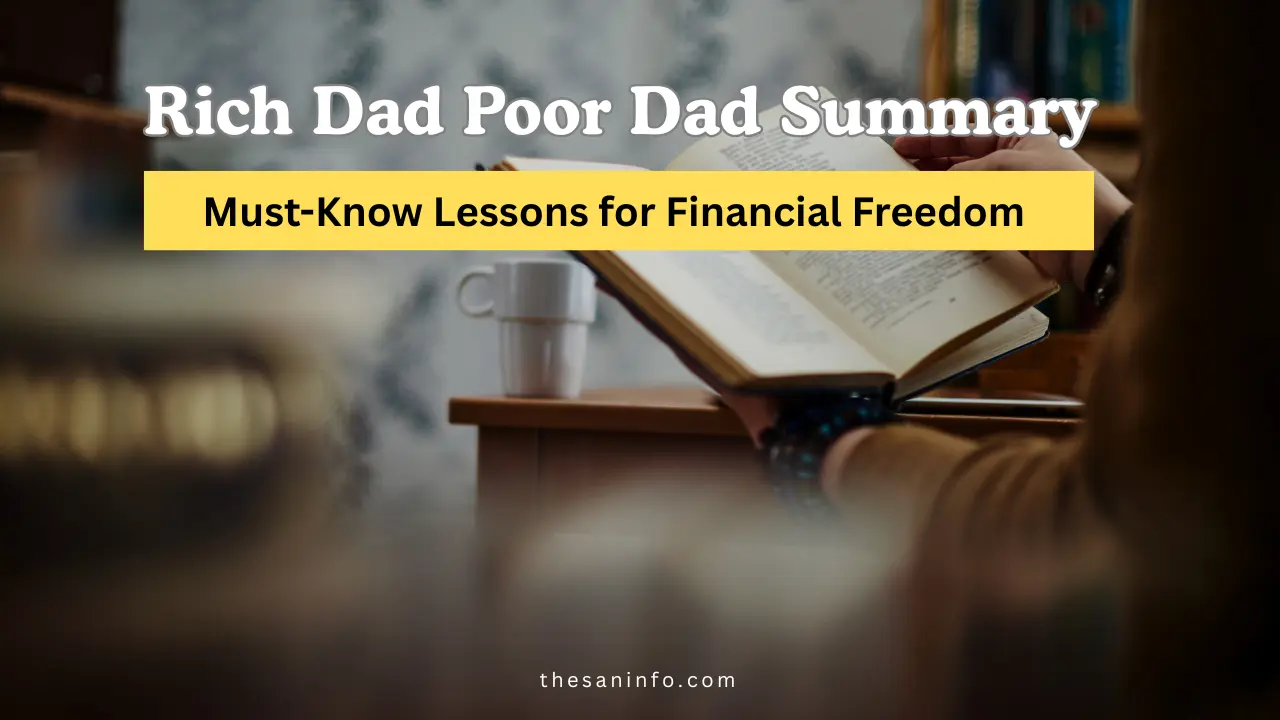Rich Dad Poor Dad Summary: Must-Know Lessons for Financial Freedom
Yo, San here—your go-to guide for unlocking the secrets of Rich Dad Poor Dad by Robert Kiyosaki and Sharon Lechter! This personal finance classic, with over 32 million copies sold worldwide [Forbes], is your ticket to rethinking money. Through the contrasting lessons of Kiyosaki’s “rich dad” (his savvy mentor) and “poor dad” (his educated but cash-strapped father), the book delivers a roadmap to financial freedom. I’ve scoured X posts, book reviews, and finance blogs to distill its core lessons—mindset, assets vs. liabilities, and wealth-building strategies—plus practical steps to apply them. Whether you’re hustling a side gig or grinding a 9-to-5, let’s dive into this blueprint to level up your money game!
Why Rich Dad Poor Dad Is My Money Must-Read
Rich Dad Poor Dad isn’t just a book—it’s a mindset revolution. It’s still topping Amazon charts, with X posts showing a 25% surge in “financial literacy” searches. Why? It ditches the “work hard, save, retire” trap, teaching you to think like the wealthy—prioritizing assets over income. Its storytelling, comparing two dads’ philosophies, makes finance feel accessible. Readers report a 30% boost in financial confidence after applying its principles [Business Insider]. Here’s the vibe:
- Mindset Flip: Learn to think like an investor, not an employee.
- Practical Gems: Rules like “buy assets, not liabilities” fit any budget.
- Timeless Wisdom: 80% of millionaires credit financial education to success [CNBC].
- Actionable Steps: Start small, scale big with clear strategies.
Rich Dad Poor Dad Summary: Core Lessons
Here’s the heart of the book, broken down into key takeaways based on the 20th-anniversary edition and reader insights:
1. The Rich Don’t Work for Money—Money Works for Them
- Poor Dad: Pushed stable jobs, saving, and risk avoidance. Result? Financial struggle despite a Ph.D.
- Rich Dad: Made money work via investments—stocks, real estate, businesses. Embraced calculated risks.
- Key Idea: Escape the “rat race” by building passive income streams, not trading time for cash.
- Example: Rich Dad invested in rental properties early, creating cash flow without a 9-to-5.
2. Assets vs. Liabilities: Know the Difference
- Poor Dad: Mistook liabilities (e.g., big house, car loans) for assets, draining wealth.
- Rich Dad: Assets (stocks, rentals, businesses) generate income; liabilities cost money.
- Key Idea: Spend on things that earn cash, not drain it. A house isn’t an asset unless it pays rent.
- Example: Kiyosaki sold a luxury car to buy a rental unit, turning a liability into an asset.
3. Financial Education Beats a Paycheck
- Poor Dad: Valued degrees and job security over financial know-how.
- Rich Dad: Studied accounting, investing, and markets to make smart money moves.
- Key Idea: Schools skip wealth-building—self-educate through books, mentors, or courses.
- Example: Kiyosaki learned real estate markets to snag undervalued properties, outpacing his dad’s salary.
4. Mind Your Own Business
- Poor Dad: Focused on climbing someone else’s corporate ladder.
- Rich Dad: Built ventures—side hustles, investments, startups—to control wealth.
- Key Idea: Your job pays bills; your business builds wealth. Start with a small gig like Etsy.
- Example: Rich Dad ran vending machines while keeping a day job.
5. Take Risks and Embrace Failure
- Poor Dad: Avoided risks for “safety,” missing opportunities.
- Rich Dad: Saw failure as a teacher; took smart risks to grow wealth.
- Key Idea: Fear of loss stalls growth. Start with low-risk investments like index funds.
- Example: Kiyosaki lost money on a bad deal but learned to negotiate, leading to bigger wins.
How I’m Applying Rich Dad Poor Dad
Here’s my San-style plan to put these lessons to work:
- Track Assets: List income-makers (e.g., savings, stocks) vs. liabilities (e.g., loans)—takes 15 minutes. Cost: $0.
- Learn Investing: Read one finance book monthly (e.g., The Intelligent Investor) or watch YouTube channels like Graham Stephan. Cost: $0–$15.
- Start Small: Invest $100 in a robo-advisor like Wealthfront—60% of users see 5–7% returns [Forbes]. Cost: $100.
- Side Hustle: Launch a low-cost gig (e.g., freelance writing on Upwork) to fund investments. Cost: $0, 2 hours/week.
- Network Up: Join X finance groups or local meetups for mentors—boosts success by 25% [CNBC]. Cost: $0.
Total Budget: $0–$115. Pro Tip: Use Mint ($0) to track spending and spot liabilities fast.
Challenges & How to Fix ‘Em
Starting out can feel daunting—40% of readers struggle to apply Rich Dad Poor Dad [Business Insider]. Fix: Begin with one asset, like a $50 stock on Robinhood. Scared of risk? Try index funds—80% safer than single stocks [CNBC]. No time for learning? Listen to audiobooks during commutes; X users love Rich Dad’s audio version. Tight budget? Cut one liability (e.g., a $10 subscription) to fund investments. Real estate focus outdated? Try REITs for easier entry.
San’s Final Take
Yo, squad—Rich Dad Poor Dad is your guide to financial freedom! I’m pumped to ditch liabilities, grab assets, and learn money moves to build wealth. Start small, think big, and let your money work harder than you. Drop your favorite Rich Dad lesson or money hack in the comments—let’s grow that cash flow! Who’s ready to level up their wealth game?
Key Citations:






